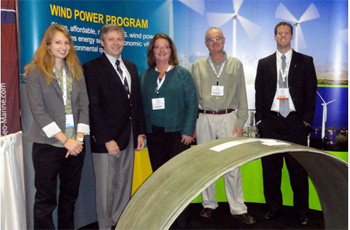Dec 8 2011
Bayer MaterialScience LLC has developed a new polyurethane-based composite technology in response to the wind power industry’s desire for stronger, longer wind blades. A development team led by Bayer found polyurethane chemistry to dramatically improve fatigue and fracture toughness properties over epoxy-based systems used commercially today.
This new technology was well received by the U.S. Department of Energy (DOE). The Department invited Bayer to display a prototype wind-turbine blade root ring – the ring that wraps around the base of the blade where it is fastened to the wind turbine blade shaft – at the recent American Wind Energy Association (AWEA) Off-Shore Windpower Conference and Exhibition in Baltimore. The successful development was funded by Bayer, the DOE and Molded Fiber Glass Companies, Inc. in a public/private sector partnership.
 A new composite technology from Bayer MaterialScience LLC was well received at the recent American Wind Energy Association (AWEA) Off-Shore Windpower Conference and Exhibition
A new composite technology from Bayer MaterialScience LLC was well received at the recent American Wind Energy Association (AWEA) Off-Shore Windpower Conference and Exhibition
“It’s gratifying for our development to be highlighted, particularly in light of the many wind technology projects funded by the Department of Energy’s Energy Efficiency and Renewable Energy program in the past year,” said Mike Gallagher, director, Public Sector Business, Bayer.
The Department of Energy saw value in Bayer’s proposal to develop materials that allow blades to be lighter, stronger and longer. Blade length is important since the power generated by a wind turbine is related to the area swept by the blades. Doubling the blade length generates four times more power. Reducing blade height has another advantage: less strain is put on turbine components, which translates into reduced operations and maintenance costs.
“We are proud of our achievement because it showcases Bayer’s ability to bring material solutions to solve unmet market needs,” said Sharon Papke, head, BMS NAFTA Wind Energy, Bayer. “This development should make a significant contribution to wind power as a key component of sustainable energy.”
A key property for wind turbine blades is the inter-laminar fracture toughness. The incorporation of Baytubes® reinforcement technology into the polyurethane composites improved the fracture toughness by as much as 48 percent, which is double the fracture toughness of epoxy. The new composites also had superior processing and handling properties, potentially serving to lower total manufacturing cost by as much as 16 percent. This combination of cost and performance gives blade designers new options to capture wind energy more reliably and efficiently.
With these promising results, Bayer is working to expand this work to manufacture, test and certify full-scale prototype blades in collaboration with wind industry experts. The development team, headed by Bayer’s Usama Younes, principal scientist, also includes Case Western Reserve University (Cleveland, OH) and Molded Fiber Glass Companies, Inc. (headquartered in Ashtabula, OH).